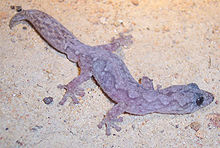
Oedura is a genus of medium to large geckos, lizards in the family Diplodactylidae. The genus is endemic to Australia. Species in the genus are referred to by the common name velvet geckos.

The broad-headed snake is a species of venomous snake in the family Elapidae. The species is restricted to the Sydney Basin in New South Wales, Australia. It is one of three snakes in the genus Hoplocephalus, all restricted to eastern Australia. It is currently endangered in New South Wales and is listed as vulnerable under the Commonwealth Legislation.
Christinus guentheri is a species of lizard in the family Gekkonidae (geckos). The species is endemic to two Australian islands, Norfolk Island and Lord Howe Island.
Uvidicolus is a monotypic genus of lizard in the family Carphodactylidae. The genus contains the sole species Uvidicolus sphyrurus, also known commonly as the border thick-tailed gecko. The species is endemic to Australia.

Amalosia rhombifer, also known commonly as the zigzag velvet gecko and the zig-zag gecko, is a species of lizard in the family Diplodactylidae. The species is endemic to Australia.

Lucasium steindachneri, commonly called the box-patterned gecko or Steindachner's gecko, is a species of nocturnal, medium-sized lizard in the family Diplodactylidae. The species has a pale strip with three patches of brown along its back. This gecko is terrestrial and only found in arid and semi-arid areas of continental Australia.

The northern spiny-tailed gecko is a species of lizard in the family Diplodactylidae. The species is endemic to Australia.

Amalosia jacovae, also known commonly as the clouded gecko or the clouded velvet gecko, is a species of lizard in the family Diplodactylidae. The species is endemic to Australia.
Amalosia obscura, also known commonly as the slim velvet gecko is a species of lizard in the family Diplodactylidae. The species is endemic to Australia.
Diplodactylus fulleri, sometimes called the Lake Disappointment ground gecko, is a species of gecko, a lizard in the family Diplodactylidae. The species is endemic to Australia.
Diplodactylus klugei is a species of gecko, a lizard in the family Diplodactylidae. The species is endemic to Australia.
Diplodactylus savagei, known commonly as the yellow-spotted Pilbara gecko, is a species of lizard in the family Diplodactylidae. The species is endemic to Australia.
The Pilbara ground gecko also known commonly as Wombey's gecko, is a species of lizard in the family Diplodactylidae. The species is endemic to Australia.
The northern velvet gecko is a species of lizard in the family Diplodactylidae. The species is endemic to Queensland in Australia.
Oedura coggeri, commonly known as the northern spotted velvet gecko, is a species of gecko, a lizard in the family Diplodactylidae. The species is endemic to Queensland, Australia.

The southern spotted velvet gecko, also known commonly as Tryon's velvet gecko, is a species of lizard in the family Diplodactylidae. The species is endemic to Australia.
The western spiny-tailed gecko is a species of lizard in the family Diplodactylidae. The species is endemic to Australia.
Cyrtodactylus sadleiri, also known commonly as Sadleir's bow-fingered gecko and the Christmas Island forest gecko, is a species of lizard in the family Gekkonidae. The species is endemic to Christmas Island, Australia.
Nactus cheverti, also known commonly as Chevert's gecko, the Fitzroy Island gecko, and the southern Cape York nactus, is a species of lizard in the family Gekkonidae. The species is endemic to Queensland in Australia.

Saproscincus challengeri, also known commonly as the Border Ranges shadeskink, Challenger's skink, the challenging shade skink, and the orange-tailed shadeskink, is a species of lizard in the family Scincidae. The species is native to New South Wales and Queensland in Australia.









